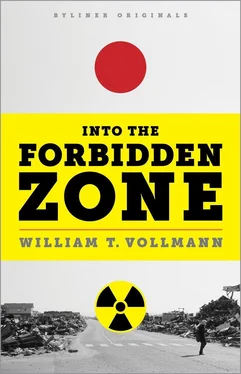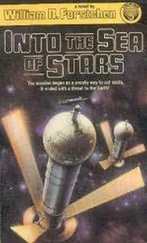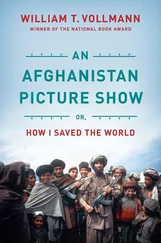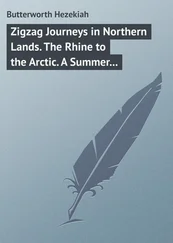Night globes glowed in a roadside restaurant, and then at a gas station. We rolled across the Inasokamatsi River, then down through a cut tasseled with golden grass, a gray-green volcanic-shaped mountain projecting itself ahead upon the pale cloudy sky. An old man in a russet robe toiled slowly uphill toward his house, swaying from side to side. Presently we entered the municipality of Funehiki. The driver said, “You know Chernobyl? I watched on the news; there was a ninety-year-old woman who grows her own vegetables, lives alone, and gets sick occasionally but is basically fine.” How inspiring, I thought.
Turning away from the route that led to the famous limestone caves, he said, “Where we are going is about forty kilometers from the plant. If you stay on this road, you will go straight there,” at which the back of my neck prickled slightly. “If you pass that point up there, you approach the mountain and then you go down again.”
“Have you ever been there?”
“Once. It was a tour. At that time we never thought this could happen.”
That afternoon while we waited for the rain to stop, the interpreter and I had swallowed our Cold War — era potassium iodide tablets, courtesy of my friend Dave, who had purchased a bottle at some gun show. The bright yellow-green, crumbling pills were to be taken only in the event of fallout, said the label. (My tongue tingled for days and I got a rash; the interpreter remained unaffected.) In retrospect I am ashamed that we did not think to bring one along for our driver. Fortunately, the meter remained at 2.4.
We entered the town of Tokiwa and stopped at the shrine. The mask had fogged up my glasses so badly that I pulled it off, gratefully inhaling the chilly air. The interpreter and I ascended the stone stairs. Above the wooden-slatted offering box, the immense corn-hued tassel, the size and proportions of a girl-child’s skirt, barely swayed in the breeze, ferruled (if that is the word) by a tall hexagon engraved with the name of the person who had dedicated it. Climbing the last wooden steps in stockinged feet as tradition requires, I peered into the windows of the place and, as usual, saw mostly darkness, interrupted by the reflection of that tassel behind me and by indistinct golden gleamings deep within. My heart revolted at slipping the mask back on, but I did, descending toward the pines and clouds and down to the steep edge of this high place, down the decrepit stone steps, which might have been damaged by the earthquake. I could smell the pines.
Informing the driver that the dosimeter still indicated a safe amount of radiation, I asked whether he would be willing to take us farther.
“Sure,” he laughed. “I’ll take you to the point where you can’t go anymore.”
“The radio announces it every day,” he remarked. “For the past few days, this area has had a very low level.”
So we drove up the road toward Futaba, the pallid roofs of houses fading into the low oaks. “This area is close to the plant, but they say it is not just distance but also geography,” he explained. Suddenly we reached a yellow signboard, no more impressive than any sidewalk restaurant’s, whose red letters warned: DANGER: ENTRY IS RESTRICTED 10 KILOMETERS FROM HERE. We had entered the voluntary evacuation zone. From here on, the road was quite empty. The next village was virtually lightless, except for the yellow windows of three sidewalk vending machines from which no one had yet pulled the plugs. Another sign for Futaba and an indication that we were still on Highway 288 separated us from the following village. Now it had become nearly pitch dark, although I could infrequently make out the silhouettes of forest ridges.
I told the driver that this excursion was very interesting. He chuckled: “I am ready to cooperate as much as possible, because anyway I don’t have much longer to live.”
There came another winding stretch. Soon we would arrive at Miyako Oji (twenty kilometers from the reactor), beyond which rose a mountain that would, I hoped, protect us from beta particles and gamma rays. I inquired whether there might be any legend relative to Miyako Oji; the driver replied that there was not. “What’s popular in this vicinity is beetles for the kids. They produce them here.” As a matter of fact, the interpreter had once purchased a pet beetle for her sons (although whether or not it came from Miyako Oji she did not know); it failed to thrive, I am sorry to say. When we turned right at the junction for Inaki, it was quite dark. “Most of them are gone, I guess,” said the driver.
And so we came to the inner ring, where tall signs with black and red letters interrupted the road, the prefecture proclaiming that further travel was forbidden while the police merely announced that it was restricted. In the darkness beyond lurked a police riot bus, empty or not. Since there was nothing to see and the hazards (including perhaps arrest) were unknown, I could not in good conscience ask the driver and the interpreter to go any farther that night, brave though they were. We did take a spin through Miyako Oji, whose houses seemed intact but dark. A lonely white dog trotted up to the taxi, looking up at us hopefully; as we continued on our way it darted crazily back and forth. The driver remarked that the evacuation centers such as Big Palette did not allow any pets, which therefore had to be left behind. Should I have tried to take it to some animal shelter in Koriyama, if there were such a place? Who knew how contaminated the creature was?
“It’s the first time that I’ve seen this here,” said the driver. “It’s like a ghost town. About twenty years ago in Koriyama, on Christmas Eve a cable fell, and there was a blackout, so black! And this is the first time since then.”
As we began to drive away from the reactor I pulled my mask off and instantly tasted dust in my throat, which made me anxious, because what if the dosimeter were lying? It was all I had to go on, really.
The old driver said, “What’s the most scary around here is the wind that comes from the sea. That’s when the radiation comes. In summer, that’s when it comes.”
A quarter-hour later, at eight o’clock, the dosimeter clocked 2.5 millirems.
THEY DID IT FOR THE NATION
ON THE FOLLOWING MORNING, a Sunday, which began chilly and breezy while the dosimeter displayed its predicted 2.6 millirems and the hotel television explained that the overflow trench for the contaminated reactor would soon itself overflow, we set out for the danger zone once more. As before, I wore my ball cap (a convenient resting place for airborne beta particles), my house-paint-spotted old raincoat (quite inappropriate for appearance-conscious Japan) whose virtues were its hood and its expendability — this magnificent accessory was intended to go over a disposable poncho whose sleeveless armholes I would seal with masking tape around the raincoat’s sleeves; beneath this was an optional sweater of polyester fleece, for the tsunami zone had been chilly; then came my fifteen-year-old long-sleeved shirt (just broken in; a shame to lose it, but anyhow I had worn it before for chemical experiments), and in the breast pocket of this lived my dosimeter; beneath this shirt I wore another lighter one. The idea was to pull on my yellow kitchen gloves at the last moment, taping them around the cuffs with masking tape; then came my old blue jeans and underpants, my grubby socks still soggy with tsunami scum, my late father’s old shoes, disposable shoe covers at the ready — and, of course, my respirator, guaranteed to filter out 99.97 percent of all particulate matter, although, since I had bought it at an American hardware store, the label advised me that misuse might cause injury or death.
I had brought a second set of all the exotic items for the interpreter (who in due course would inherit the dosimeter). Needless to say, the poncho, gloves, masking tape, and shoe covers had not graced my person so far on this adventure; all the other clothes I had been wearing unstintingly, day after day, since I had to suppose that everything I did not store in Tokyo might become contaminated, so why throw away more than I had to? Although I succeeded in showering every day except in Oshima, I doubt that I made a very professional show. The notebook I carried, a scarlet-spined yellow affair emblazoned with a pink-tutued ballerina who curtseyed from beneath a cloud of multicolored butterflies, might have been what tipped the scales, causing policemen to snicker softly the instant my back was turned. Never mind; even in former years, when I had been younger and slimmer and needed to dress up for interviews in my one and only business suit, my best achievement was a look of mild surprise on the interpreter’s face, accompanied by this encomium: “You look almost handsome!”
Читать дальше












